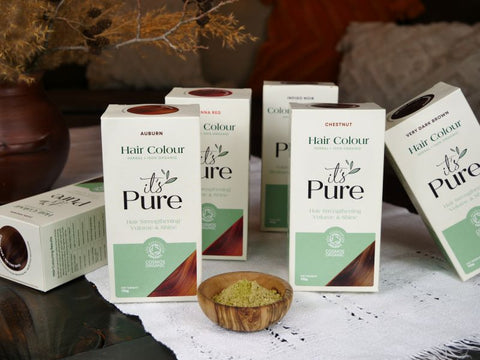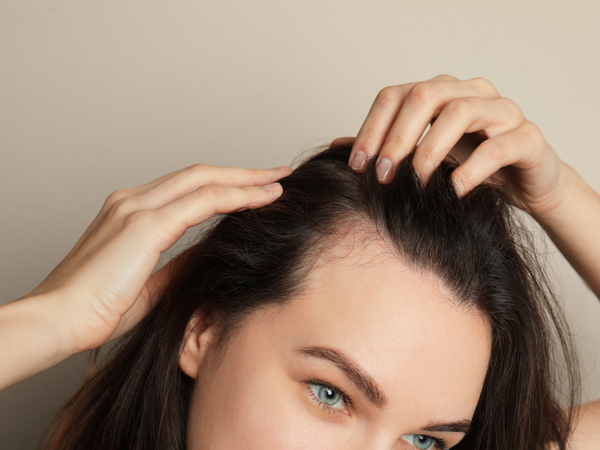How To: Our Vegan Henna Gloss Recipe

How To: Our Vegan Henna Gloss Recipe
How to make Henna Gloss is one of our most asked questions, so we’ve come up with our own recipe below, that gives our how to.
A Henna Gloss is more of a nourishing hair mask than a Henna Dye; it won’t give as strong or rich a colour, but is rich in moisturising ingredients. If your hair is prone to frizz, breakage, dryness or damage, a henna gloss will absolutely benefit you.
You’ll want to leave it in for an hour at least to get the full benefits in your hair; leave on for longer if you want a much more vibrant colour.
Typically a Henna Gloss only works for pure, red Henna - unfortunately you can’t substitute one of our pre-mixed shades for this! If you’re aiming for another colour, or don’t want to colour your hair at all, we’ve come up with some tips below.
What makes our recipe vegan?
While our Henna powders are completely vegan and cruelty free, some henna gloss recipes call for the use of animal by-products in the mix - yoghurt, honey, buttermilk or egg can all be added to a henna gloss to aid moisture, strength and shine.
However, great hair doesn’t need to come with a compromise on your ethics!
You can use natural, plant based products that give similar effects and shine to your hair, without costing the earth.
Making your own mix is really simple, and the ingredients you use can be tweaked depending on your own personal preference.
What Henna Can I Use?
Firstly, it’s best to use Body Art Henna, rather than Hair Quality.
When mixing with a thinner liquid, hair quality henna mixes well, which is why it is so good when making a henna dye! When using a thicker base, to make a henna gloss, the Body Art Quality has finer granules that mix more smoothly - and will rinse more easily from your hair.
What Do I Mix With?
Instead of water, citric acid or tea, you’ll need to mix your Henna with a moisturising ingredient.
Full fat, canned, pure coconut milk works best for this - yes, the type usually used in cooking! It’s thicker than coconut oil but has the same hydrating benefits for hair, and the consistency of the mix will help the henna to bond more readily with your hair.
It also acts as a protein agent; so if you’re noticing damage, breakage or real dryness (especially in your ends) it will aid repair of these.
You can substitute this for a natural conditioner, and we would recommend the Odylique Conditioner for this purpose, as it is quite a thick conditioner and doubles up as a moisturising hair mask. This isn’t as protein rich, so if you really want to get that benefit, stick to the coconut milk!
One optional add-in to your mix is pure apple cider vinegar. Add in 2 tablespoons for a mix with 100g of Henna. It works as a clarifier, helping to remove any build up in the hair, or scalp. It aids with shine, and condition, and helps with knotting or tangles in the hair (as well as naturally taming frizz!)
Add In Essential Oils.
Using the right essential oil in your mix is so good for your hair. You will really only need 2-3 drops of essential oil in a mix for 100g Henna.
Ylang ylang is the queen of essential oils for hair. It works for all hair types, providing shine and condition. If you have a wave or curl pattern, it’s also reputed for helping protect hair’s natural structure. As a bonus, it’s often used as a hair perfume (so your hair will smell great!)
Not a fan of Ylang Ylang? You could try some other essential oils, as below:
Lavender oil is a fantastic hydrator for hair, so if your hair is lacking moisture or feels particularly dry, absolutely add this to your mix.
If you’re really struggling with dry scalp, dandruff, or itching, add in some Cedarwood; it aids circulation on the scalp and nourishes dry, irritated skin.
For thinning, breaking hair, use Geranium. Geranium is strengthening for hair, offering gentle hydration and preventing breakage.
Here's a before and after of my own henna gloss mix. I used coconut milk, apple cider vinegar and ylang ylang oil to mix with 100g of Henna, and left for 2 hours.

How To Achieve A Gloss Without A Colour
If you’re happy with your hair colour, are trying to grow out the grey, or just want to give your hair good condition without any colour, don’t fret - you can substitute the Henna in our recipe for pure Cassia powder.

If you have gorgeous grey and you’re looking to properly moisturise it, a Cassia Gloss would work really well - and making sure you use Lavender oil in the mix is key.
Lavender is great for grey hair, promoting circulation, improving hair thickness and locking in moisture.
If you use a Cassia gloss, it isn’t typically as fine as Body Art Quality Henna, so you might find you need a little shampoo to fully rinse the gloss from your hair.
Can A Henna Gloss Work For Brown, or Black hair?If you are currently aiming for a dark shade with our dyes, such as a black or brown, then a gloss won’t work in terms of achieving your colour.
Indigo is the ingredient in those dyes and recipes that gives a brown, or black shade; and unfortunately it is a lot more finicky than Henna!
Use our Cassia Gloss as mentioned above as a moisturising hair mask; but be aware if adding any oils, these can fade your colour a little more quickly - so you might want to stick to just using the coconut milk, or conditioner, instead.
For more recipes, tips and ideas, look at our blog, here >>>
If you have any questions, contact us here >>>






